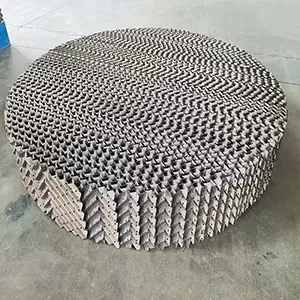What Is structured packing?
Structured packing is a type of industrial packing used in separation processes such as distillation, absorption, stripping, and extraction. It is characterized by its regular, ordered, and geometrically uniform structure, designed to optimize gas-liquid contact and enhance mass transfer efficiency in towers or vessels.

Core Structural Characteristics
Unlike random packing, which consists of loose, irregularly shaped particles, structured packing features a systematic arrangement of interlocking or stacked modules. These modules are typically made from thin sheets (metal, plastic, or ceramic) formed into corrugated patterns, grids, or meshes. The corrugations are oriented at specific angles (commonly 30° or 45°) and alternate direction between adjacent layers, creating a network of uniform, parallel channels. This ordered design ensures consistent distribution of gas and liquid phases, minimizing issues like channeling, bypassing, or uneven flow that can reduce efficiency in random packing.
Key Advantages
Structured packing offers several performance benefits:
- High mass transfer efficiency: Its large specific surface area and uniform flow channels maximize contact between gas and liquid, enabling precise separation of components.
- Low pressure drop: The streamlined channel structure reduces resistance to gas flow, lowering energy consumption compared to many random packing types.
- Scalability: Its modular design performs consistently across different tower diameters, making it suitable for both small-scale laboratory setups and large industrial towers.
- Versatility: Available in various materials (metal, plastic, ceramic) and configurations, it can be tailored to handle diverse conditions, including high temperatures, corrosive environments, or high-purity requirements.
Common Types and Applications
Common forms of structured packing include corrugated sheet packing, mesh packing, and grid packing. Corrugated sheet packing, the most widely used type, is favored for its balance of efficiency and durability. It is employed in industries such as petrochemicals, pharmaceuticals, environmental protection, and food processing. For example, in fine chemical distillation, structured packing ensures high-purity product separation, while in wastewater treatment, it enhances the absorption of volatile contaminants.
In summary, structured packing is an engineered packing solution defined by its ordered structure, superior mass transfer performance, and adaptability to diverse industrial separation needs. Its design prioritizes efficiency, consistency, and reliability, making it a critical component in modern chemical and process engineering.

